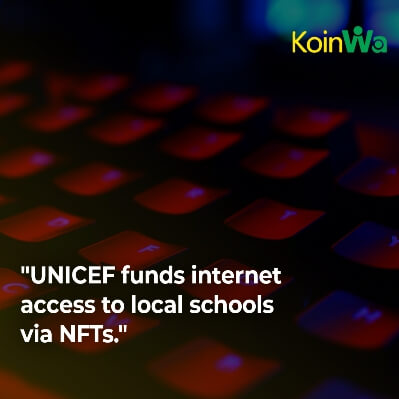UNICEF, a renowned humanitarian aid outfit is raising funds to help provide internet access to schools in developing regions globally through NFTs.
The project is called the “Giga initiative,” and it’s aimed to help over 1 million schools across 49 countries worldwide.
Through a joint venture with the International Telecommunication Union (ITU), the UNICEF-led initiative looks to tackle the project dilemma in a novel way.
Gerben Kijne, blockchain product manager at Giga, outlined the firm’s Project Connect initiative at the Blockchain Expo in Amsterdam.
Giga has made strides in connecting schools to the internet in developing countries around the world.
It has been observed that about 2.9 billion people still do not have connectivity to the World Wide Web.
Data provided by UNICEF highlights that the majority of the people who lack internet service reside in undeveloped countries, as well as children continue to be disadvantaged by the lack of internet connectivity at local schools.
Strategies adopted for disbursement by UNICEF
- The first step in the process for the initiative was mapping schools and their connectivity through Project Connect. Giga utilizes machine learning technology to scan satellite images to identify schools on an open-source map. To date, it has pointed over 1.1 million schools across 49 countries, and connectivity data for a third of these schools.
- After identifying the number of schools in need of internet accessibility, through project Connect, the next step in the process is creating a novel fundraising initiative that taps into the world of blockchain, cryptocurrencies, and non-fungible tokens
- In an interview, after his keynote address at the RAI Convention Centre in Amsterdam, Kijne unpacked Giga’s Patchwork Kingdoms initiative. With NFTs surging in popularity over the past couple of years, Giga looked to make the most of the craze through its NFT-led fundraising experiment in March 2022.
- To utilize NFTs, Giga teamed up with Dutch artist Nadiesh Bremer, who is Snowcrash Lab’s data visualization scientist and artist to launch a collection of 1,000 procedurally generated NFTs minted on the Ethereum blockchain. The NFTs were produced using Giga’s school data to represent those with and without internet connectivity.
- Describing the NFTs, each piece has a world above representing connected schools, and a world below for unconnected schools. The collection of NFTs incorporates data on more than 280,000 schools from 21 countries, and each artwork represents a subset of these schools.
- The NFT public scale raised around 240 Ether in totality, valued at $700,000, which went directly to connecting schools to the internet.
- UNICEF selling 1,000 data-driven non-fungible tokens, makes it the United Nation’s largest-ever NFT collection to date, and the initiative was initially announced ahead of the commemorations of UNICEF’s 75th anniversary.
Conclusion
UNICEF seeks to capitalize on the potential of the digital revolution for every child to thrive, including a variety of high-profile priorities such as mental health and climate change.
Having the potential NFTs, collectors will own a snapshot of Giga’s progress, however, developments to the NFTs will include the ability to collect individual schools, connect Patchwork Kingdoms, and observe the network of city spaces grow as Giwa evolves and more schools and communities are connected.



